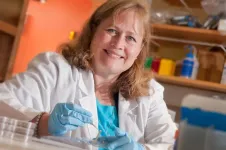(Press-News.org)
Researchers in the lab of Michael Sigal at the Max Delbrück Center and Charité – Universitätsmedizin Berlin have elucidated the role of the p53 gene in ulcerative colitis. The study, published in Science Advances, suggests a potential new drug target to stop disease progression to cancer.
A team of researchers led by Kimberly Hartl, a graduate student at the Berlin Institute for Medical Systems Biology of the Max Delbrück Center (MDC-BIMSB) and Charité – Universitätsmedizin, have shed new light on the role of the p53 tumor suppressor gene in the pathogenesis of ulcerative colitis (UC) – an inflammatory bowel disease that afflicts an estimated five million people worldwide and that is linked to an increased risk of colon cancer. The research points to a new way to stop the disease from progressing. The study was published in the journal Science Advances.
“In patients with ulcerative colitis who are at high risk for developing cancer, we could potentially target aberrant cells and get rid of them early, before any cancer occurs,” says Professor Michael Sigal, Group Leader of the Gastrointestinal Barrier, Regeneration Carcinogenesis lab at MDC-BIMSB, Head of Luminal Gastroenterology at Charité, and a senior author of the paper.
A key role for p53
Ulcerative colitis affects the large intestine, specifically areas called “crypts,” tube-like glands within the epithelial tissue that lines the intestine. Crypts contain stem cells and other cell types that maintain the health and normal function of the colon, such as absorbing nutrients or secreting mucus.
When the colon is injured, epithelial crypt cells enter a “repair mode.” They begin to proliferate rapidly to fix the injury. However, in patients with UC and UC-related colon cancers, these cells become stuck in repair mode, which scientists refer to as a “regenerative cell state.” As a result, there are too few mature cells. Consequently, the colon struggles to function normally, which triggers even more stem cell proliferation in a toxic feedback loop.
In the current study, Hartl found this defective repair mechanism is linked to a non-functional p53 gene, which plays a key role in regulating the cell cycle and in repairing DNA.
“If there is no p53, cells remain in a proliferative state,” Sigal explains.
Existing tests to find precancerous lesions in patients with UC such as colonoscopies can identify visible lesions that sometimes are not easy to remove, says Sigal. This study could be a first step in developing molecular tools for a less invasive diagnostic test that would allow physicians to identify the aberrant cells much earlier, even before visible alterations occur, he adds.
Regeneration gone hay-wire
To study the repair process, the researchers developed a three-dimensional organoid – a mini organ – model of the colon grown from mouse stem cells.
Together with specialists in DNA and RNA sequencing as well as proteomics and metabolomic technology at the Max Delbrück Center, they found that cells in organoids lacking p53 are stuck in the regenerative state. Thus, the cells metabolize glucose more rapidly via the process of glycolysis. By contrast, when p53 is active, it diminishes glucose metabolism and signals cells to re-enter a healthy state.
The scientists then treated the organoids with compounds that interfere with glycolysis to test whether they can target these highly proliferative cells. They found that cells that lacked the p53 gene were more vulnerable to this treatment than normal cells. “With organoids, we can identify very specific agents that can target metabolic pathways and point us toward potentially new therapeutics to selectively target mutated cells,” Hartl adds.
The next step is to transfer these findings to the human setting. The researchers are also now studying the repair process in more detail with the goal of developing more simple methods to identify cells with defective p53 genes in colon tissue.
“Once we have a simple method of identifying these individual cells in colon tissues, we could perform clinical studies to selectively kill them, and then analyze whether this is associated with a lower risk of developing cancer,” says Sigal.
Further information
Sigal Lab
Proteomics and Metabolomics Platform
Sanders Lab
Literature
Kimberly Hartl, Safak Bayram, Alexandra Wetzel, et al. (2024):“P53 terminates the regenerative fetal-like state after colitis-associated injury.” Science Advances. DOI: 10.1126/sciadv.adp8783
Max Delbrück Center
The Max Delbrück Center for Molecular Medicine in the Helmholtz Association (Max Delbrück Center) is one of the world’s leading biomedical research institutions. Max Delbrück, a Berlin native, was a Nobel laureate and one of the founders of molecular biology. At the locations in Berlin-Buch and Mitte, researchers from some 70 countries study human biology – investigating the foundations of life from its most elementary building blocks to systems-wide mechanisms. By understanding what regulates or disrupts the dynamic equilibrium of a cell, an organ, or the entire body, we can prevent diseases, diagnose them earlier, and stop their progression with tailored therapies. Patients should be able to benefit as soon as possible from basic research discoveries. This is why the Max Delbrück Center supports spin-off creation and participates in collaborative networks. It works in close partnership with Charité – Universitätsmedizin Berlin in the jointly-run Experimental and Clinical Research Center (ECRC), the Berlin Institute of Health (BIH) at Charité, and the German Center for Cardiovascular Research (DZHK). Founded in 1992, the Max Delbrück Center today employs 1,800 people and is 90 percent funded by the German federal government and 10 percent by the State of Berlin.
END
Viral hemorrhagic fevers (VHF) such as Marburg virus disease have been in the news recently, with more than 60 cases of Marburg confirmed in Rwanda. Although there are currently no cases of Marburg in the United States, and the risk of infection in the U.S. remains low, Mass General Brigham experts have collaborated with the U.S. Department of Health and Human Services (HHS) Region 1 Regional Emerging Special Pathogens Treatment Center (RESPTC) at the Massachusetts General Hospital (MGH) to support frontline healthcare facilities in ensuring that patients who are being evaluated ...
Photos
A University of Michigan study of a city in the Democratic Republic of Congo finds that the necessary process of decarbonization is repeating and recreating colonial inequalities.
The researchers argue that human rights abuses associated with contemporary cobalt mining, such as child labor, social displacement and structural marginalization, are new forms of old colonial practices. Their study is published in the journal Cities.
"We show how those colonial practices emerged through the creation of mining companies and through ...
University of Florida Distinguished Professor Christine Schmidt has been elected to the National Academy of Medicine. This prestigious honor follows her election earlier this year to the National Academy of Engineering, making her one of the few exceptional individuals to be recognized by both academies.
Election to the National Academy of Medicine recognizes outstanding professional achievement and commitment to service in the fields of health and medicine. The Academy announced the names of its 100 new members today during its annual meeting in Washington, D.C.
Schmidt, the Pruitt Family Endowed Chair in the J. Crayton Pruitt Family Department of Biomedical Engineering, was selected ...
What is the “most Canadian” animal? Spoiler: it’s not the beaver, or the moose.
Published today in the journal The Canadian Field-Naturalist, the study from a team of Simon Fraser University researchers ranks, for the first time ever, species of terrestrial vertebrates in Canada by their level of Canadian evolutionary distinctness: the amount of time animals have evolved independently from other Canadian species.
High ranked species have no close national relatives and can embody up to a hundred million years of evolution shared with none other in the country.
The study found that, overall, amphibians ...
This was shown in an international study led by clinical pharmacologist Hiddo L. Heerspink of the University Medical Center Groningen in the Netherlands. This is the first time that it has been shown that this diabetes drug, now best known as a means of losing weight, is also effective for patients with chronic kidney damage. The results of this study have been published in Nature Medicine and presented simultaneously at the annual congress of the American Society of Nephrology.
Does a diabetesdrug also work in chronic ...
Researchers at the University of Massachusetts Amherst have released a comprehensive, 194-page report assessing their decade-long examination of the social and economic impacts that followed the introduction of casino gambling in Massachusetts.
UMass Amherst’s SEIGMA (Social and Economic Impacts of Gambling in Massachusetts) is believed to be the most comprehensive investigation of casino impacts ever undertaken. The report was presented Thursday to the Massachusetts Gaming Commission during a public meeting. It synthesizes the findings from 55 interim reports and academic publications.
“We wanted to do a comprehensive ...
AUSTIN, Texas — A new lung cancer screening initiative has made significant strides in overcoming barriers to care for low-income, uninsured and minority populations in Central Texas — a critical step toward reducing disparities in lung cancer outcomes. The effort, led by Dell Medical School at The University of Texas at Austin and CommUnityCare Health Centers, implemented a patient-centered approach that includes bilingual support, mailed outreach, and no-cost screening to patients.
“Federally Qualified Health Centers like CommUnityCare serve a higher-risk population, making them great places to offer ...
WASHINGTON, D.C. - The U.S. Department of Energy (DOE) today announced a fellowship open to all U.S. students pursuing doctoral degrees in fields that use high-performance computing to solve complex science and engineering problems.
Established in 1991 and currently carrying a $45,000 annual stipend, the DOE Computational Science Graduate Fellowship (CSGF) program provides outstanding benefits and opportunities, fostering a community of energetic and committed Ph.D. students, alumni, DOE laboratory staff, and other scientists who want to have an impact on the nation while advancing their research.
Fellows ...
KENNEDY SPACE CENTER (FL), October 25, 2024–After seven months of living and working onboard the International Space Station (ISSInternational Space Station), astronauts of NASA’s eighth rotational SpaceX crew mission (Crew-8) splashed down safely off the coast of Florida. The mission, which is part of NASA’s Commercial Crew Program, included NASANational Aeronautics and Space Administration astronauts Matthew Dominick, Michael Barratt, and Jeanette Epps, as well as Roscosmos cosmonaut Alexander Grebenkin. During their mission on station, ...
The most advanced respirometry chambers in Latin America were inaugurated at the Alliance Bioversity-CIAT campus in Colombia. These are hermetically sealed spaces designed to precisely measure and analyze the concentrations of gases, such as methane and carbon dioxide, produced by animals.
This advance is part of the Low-Methane Forages, project led by the Alliance Bioversity-CIAT in collaboration with the CGIAR research centers ILRI and ICARDA and their Germplasm Banks.
The project is evaluating thousands of forage ...



